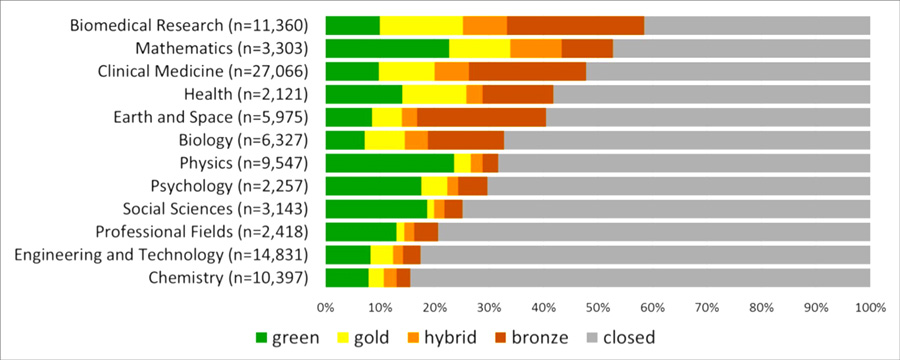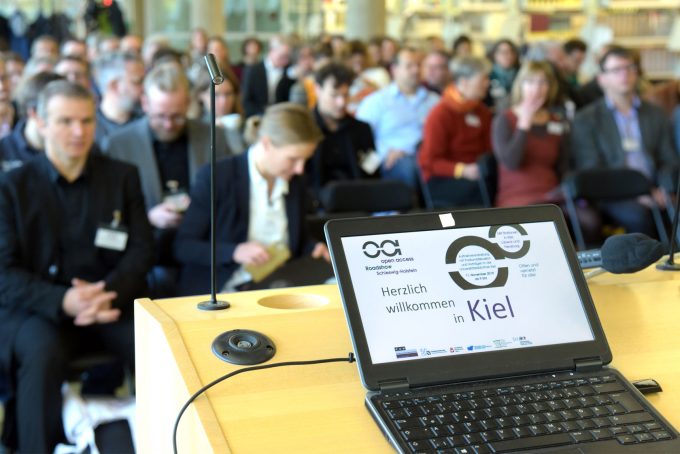
Open Access for Monographs: Small Steps Along a Difficult Path
While a considerable proportion of journal articles are now available in open access, only a few scientific monographs are currently openly accessible. Recently, however, more activities have been started and a number of reports have been published. We spoke with Olaf Siegert about the state of open access for monographs and about the activities of libraries.
we were talking with Olaf Siegert
Since 2018, open access has also gained momentum with regards to monographs, now that a significant proportion of journal articles is already available in open access (link in German language). Among other things, a series of new reports about open access monographs has recently been published:
- Towards a Roadmap for Open Access Monographs – A Knowledge Exchange Report
- The future of scholarly books is open (access)
- Digital Science Report: The State of Open Monographs – An analysis of the Open Access monograph landscape and its integration into the digital scholarly network
Olaf Siegert, Open Access Representative and Head of the Publication Services department of the ZBW – Leibniz-Information Centre for Economics has, among other things, contributed to the “Stakeholder Workshop on Open Access and Monographs” and participated in creating the report „Towards a Roadmap for Open Access Monographs“. He is also active on the subject of open access for the Leibniz Association and represents the Leibniz Open Access Working Group in external committees such as the Alliance of Science Organisations in the working group Scientific Publication System, at LIBER and at Science Europe. We talked with him about the current status of open access for monographs.
What roles do monographs play in science nowadays?
Monographs only play a small role. According to a recent study, an estimated 86,000 monographs were published in 2013. That compares with around 2.4 million journal articles published in the same time. That means only around 3.5 percent of the annual output of publications are monographs, and this percentage is falling.
Depending on the discipline, the proportion and the importance of monographs vary greatly, however. Whereas monographs play hardly any role in the natural and life sciences, they make up an estimated high single-digit percentage rate of the published output in the social and economic sciences, and this is considerably higher again in the humanities. At the same time, the highest level of pressure against open access comes from the book-oriented humanities disciplines.
Unlike journals, authors of monographs still often insist on the printed edition. The reasons for this are on the one hand, the general status of a printed work in the humanities disciplines, and on the other hand, many people perceive printed works as being more pleasant. A recent Springer study “The future of scholarly books is open (access)” also showed that 70 to 80 percent of authors in the world would still like to have a printed version of their book.
The markets for monographs and journals also vary greatly with regards to the different linguistic areas: Journals that do not publish in English language have massive problems, which is why some of them have already been switching to English. This is not seen for monographs. As before, an exchange is maintained in the native language, in particular in the larger linguistic regions, for example the German linguistic area.
How widespread is open access for monographs currently?
Of the approximately 86,000 monographs published every year, perhaps 2,000 to 3,000 appear in open access, so around 2.3 to 3.5%. The proportion of open access here is currently lagging significantly behind that of the journal market. Depending on the study and the calculation, up to 28 percent of journal articles are available in open access today.

Are there already measures that are actively supporting open access for monographs?
Yes, there are. In Germany at the moment, for example, several support funds especially for open access monographs are being created. The three Berlin universities – the FU Berlin, Humboldt University and TU Berlin – have established their own support funds for monographs, and the Leibniz Association has also been supporting the open access status for books for their authors via this instrument since the beginning of the year.
In your opinion, which participants have the best opportunities to push through open access for scientific books?
The main purchasers of monographs are libraries; a large proportion of the financing for publishers goes directly through them. Unlike the majority of journals, subscriptions to which go out all over the world, monographs are often sold only in a national context or within their own linguistic region. For that reason, typically only a few hundred copies are printed. Furthermore, unlike in the journal market, there are only a few global publishing groups. Most of the publishers are small to medium-sized, there are many of them, and they are often rooted in terms of language and discipline. Libraries therefore have in principle a good opportunity, working together with the corresponding publishers, to promote open access business models. They may already have some successes through amalgamations into small consortia.
How can libraries promote open access for monographs in real terms?
As mentioned already, libraries should establish their own support funds for open access monographs for their authors. In addition, libraries play a significant role in making open access monographs more visible. They should display the monographs more prominently in their catalogues. Their metadata are also important in making them easy to find in search engines.
Crowdfunding models that libraries use to support monographs in a collaborative manner are also interesting. Probably the best-known model for this is the private sector initiative Knowledge Unlatched. Knowledge Unlatched on the one hand wins the publishers over to provide open access monographs, and on the other hand it also collects the financial contributions from libraries that are required for this.
An additional approach for libraries would be to consider open access books as a normal part of the acquisitions budget. Libraries could negotiate open access options for e-book packages. If a book, for example, is used or downloaded frequently, one may consider negotiating with the publisher about its open access status.
An additional option would be to purchase exemption for open access backlists of books. The ZBW has used this option in the past, along with others. Open access for backlists of monographs is considerably cheaper than for new publications. At the moment, we are currently experimenting, like many others.
Furthermore, monographs should be explicitly included in institutional open access policies. Academic publishing may also represent an activity for libraries here. More than twenty German universities currently have their own university publisher, for example, and it is predominantly monographs (mostly printed and as open access) that are published there. The opportunities from distribution via repository, author support and author training courses should also be used. The monitoring is also important, as it provides information about how many publications are available in open access and how often they are used.
In addition to this, libraries should expand cross-cutting issues such as developing the skills of their employees in the scientific publication system and in author support. Furthermore, the library’s internal workflows also need to be adapted, in order to connect important areas such as licence management and the publication services with each other.
What does the European roadmap for open access monographs look like?
There is still a long way to go for a European roadmap for monographs. We are still a long way from this roadmap, which already exists for journals, like with the Plan S. This is due to the fact that there is not just one market for monographs, but rather different markets for many languages that are strongly differentiated from each other. Funding agencies will first have to increase the support for open access for monographs in their funding programmes.
Additional information
- Towards a Roadmap for Open Access Monographs – A Knowledge Exchange Report
- The future of scholarly books is open (access)
- Digital Science Report: The State of Open Monographs – An analysis of the Open Access monograph landscape and its integration into the digital scholarly network
- OA Monographs in Europe’s Research Libraries: Best-Practices, Opportunities & Challenges
- Open Access Books in Academic Libraries: How Can We Adapt Workflows & Cost Management to an Open Scholarly Communications Landscape?
- Possible roles for libraries to support Open Access books; A presentation by Olaf Siegert at the pre-conference workshop on open access books, LIBER Conference 2019, Dublin
View Comments

Real-World Laboratories: Research Infrastructures for Open Innovation and Citizen Science
Increasingly popular in recent years, real-world laboratories embody an ecosystem for...



